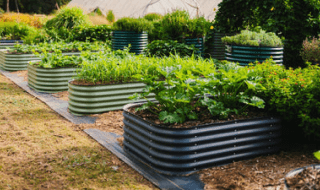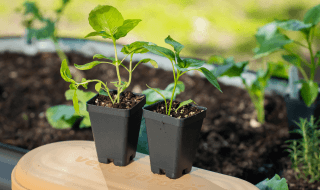Flowers and Folklore: Create a Garden Around Flower Tales (Part 1)
In the tapestry of human history, flowers have always been more than a pretty trinket.
Beyond their beauty, they've been woven into the fabric of folklore, symbolizing everything from luck and love to death and danger.
This blog post was created for those who love a good folk story and want to see more than meets the eye. It's a new approach to gardening, although you have to be mindful of the right season to plant each flower. But let's put that aside and first explore the tales surrounding each one of these six flowers, petal by petal.
Lily of the Valley: The flower of good luck

Hardiness zone: Thrives in zones 2-9.
Season to grow: Blooms in late spring.
Folklore: This delicate bloom is not just a symbol of good luck and prosperity; its folklore spans centuries and cultures. In addition to its association with Apollo's tears in Greek mythology, Lily of the Valley holds significance in Christian folklore as well. It's said that these flowers bloomed from the ground where the Virgin Mary's tears fell at the foot of the cross. As such, they're often called "Mary's Tears" and symbolize purity, humility, and the hope of renewal.
Cardinal Flower: A tale of transformation

Hardiness zone: Prefers zones 3-9.
Season to grow: Blooms in late spring.
Folklore: The vibrant red blooms of the Cardinal Flower are not just visually striking; they're steeped in folklore, especially in the southwestern United States. According to legend, these flowers possess transformative powers, capable of turning the ordinary into the extraordinary. It's believed that those who encounter the Cardinal Flower may undergo a spiritual or personal transformation, emerging renewed and revitalized.
Scottish Bluebell: Secrets of the woodlands

Hardiness zone: Flourishes in zones 3-8.
Season to grow: Blooms in early to mid-summer.
Folklore: Nestled in the misty woodlands of the British Isles, the Scottish Bluebell holds secrets whispered among the trees. According to Scottish folklore, these delicate purple blooms are not merely flowers but conduits of ancient wisdom, sharing the hidden knowledge of woodland creatures with those who listen closely. Legend has it that the ringing of the bluebell's bell-like petals is a sign of good fortune, while disturbing the flower invites the ire of the forest spirits.
Lady Slippers: Fairies in the garden

Hardiness zone: Thrives in zones 3-9.
Season to grow: Blooms in late spring to early summer.
Folklore: Lady Slippers, with their whimsical slipper-shaped blooms, have long been associated with the enchanting realm of fairies in European folklore. Legend has it that these elusive flowers serve as gateways to the fairy world, their intricate designs and delicate fragrance attracting magical beings. In some tales, it's believed that those who find a Lady Slipper in the wild are blessed with the favor of the fairies and may even receive guidance or protection from these mystical creatures.
Elder Tree: Guardian of the garden

Hardiness zone: Prefers zones 3-9.
Season to grow: Blooms in late spring to early summer.
Folklore: In the ancient lore of Germanic cultures, the Elder Tree is more than just a plant; it's a guardian of the garden and keeper of sacred knowledge. Legend has it that elder trees are inhabited by spirits known as the Elder Mother or Hylde Moer, who watch over the natural world and bestow blessings upon those who honor them. However, disturbing an elder tree without proper reverence can anger these spirits, inviting misfortune and calamity upon the perpetrator.
Poison Ivy: Beware of the the three-leafed menace

Hardiness zone: Found in zones 4-10.
Season to grow: Throughout the seasons.
Folklore: Poison Ivy's folklore revolves around its deceptive appearance and potent toxic properties. In many Native American cultures, legends warn of its dangers and emphasize the importance of recognizing its distinctive three-leafed pattern to avoid its wrath. Stories often depict Poison Ivy as a trickster plant, hiding in plain sight and luring unsuspecting victims with its innocuous appearance. Some tales even attribute malicious intent to the plant, portraying it as a malevolent force that seeks to harm those who venture too close.
Deadly Nightshade: A flower of dark secrets
Hardiness Zone: Flourishes in zones 5-8.
Season to Grow: Blooms in late spring to early summer.
Folklore: In the shadowy realms of medieval European folklore, Deadly Nightshade emerges as a symbol of darkness and danger. Associated with witchcraft and necromancy, this ominous plant was believed to possess potent magical properties, capable of inducing visions and communing with the spirit world. Its alluring white blooms, tinged with the poison of its berries, served as a warning to those who dared to pluck its forbidden fruit.
Final thoughts
These tales from the garden remind us of the intricate relationship between humanity and the natural world. Whether they bring luck or caution, joy or fear, flowers continue to enchant us with their beauty and the stories they carry!
Reflecting on these flowers, I can't help but imagine the joy of not only learning how to grow them, understanding their needs and seasons, but also unraveling their symbolism and cultural significance. Imagine how nice it would be to share these folklore tales with anyone who steps into your garden!























































































Leave a comment